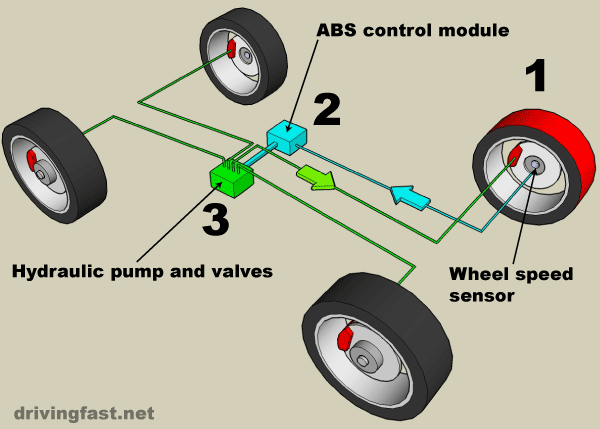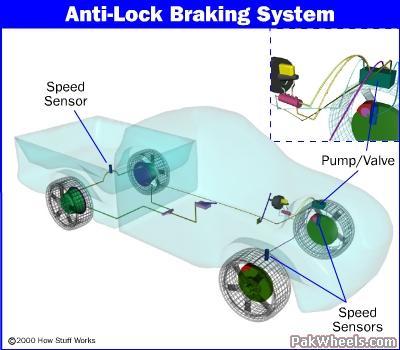

This finally started in 1984, as a technological breakthrough: unlike competing systems that were already on the market, Teves, now part of Continental, launched the MK II, the world's first microprocessor-controlled ABS for passenger cars on the road.

#DEVELOPMENT OF ANTI LOCK BRAKING SYSTEM SERIES#
The oil crisis and the subsequent weakening of the economy, which hit the automotive market particularly hard, prevented series production for years. Be that in a car, a plane, or an old experimental bus that ended up on ice at Mercedes-Benz's torture ground.However, the technology was initially only used in 36 test vehicles for the Swedish police. Of course clever differentials, good tires and working aero also plays a huge roll, but most of the data sent to the digital brain by those sensors lands back at the ABS controller, a zillion times a second. The sensors and processors of anti-lock braking also make possible every modern traction control and stability control system, from the ones that stop your burnout attempts to the ones that make you look like a hero on a racetrack. Working with the aero kits and monstrous carbon brakes on current performance cars, today's ABS can produce ridiculously short braking distances, cheat huge heavy cars through corners with ease, and help turn enormous horsepower into maximum acceleration.
#DEVELOPMENT OF ANTI LOCK BRAKING SYSTEM FULL#
It also lets manufacturers set up a number of driving modes that allow for various degrees of tire slip, ranging from almost no interaction to full assist. Maybe you don't think about it, but ABS grants us the most basic form of torque vectoring, as well as steering by braking. According to engineer Jürgen Paul, head of the ABS project at Mercedes-Benz, the decision to use digital microelectronics for the second-generation system was the real breakthrough moment in the development. They felt that in order to mass produce four-wheel multi-channel ABS, they required a digital controller. In Japan, Denso developed its Electro Anti-lock System for the Nissan President, while Toyota produced a similar system for the 1971 Crown. GM did the same for 1972, with the rear-only "Trackmaster" available on Cadillacs and Oldsmobile Tornados. Ford replied with "Sure-Track", adding it only the rear wheels of its Lincoln Continentals. Chrysler worked with the Bendix Corporation to come up with a computerized, four-wheel ABS system called "Sure Brake" for its 1971 Imperial. The result premiered in 1970, when Hans Scherenberg presented the analog-electronic "Mercedes-Benz/Teldix Anti-Bloc System" to the media at the test track in Untertürkheim.Įngineers got equally busy overseas. In 1966, the company began collaborating with the Heidelberg electronics specialist Teldix, which was later taken over by Bosch. In 1963, Daimler-Benz started working on its first electro-hydraulic brake control system. The components needed to register the rotational deceleration and acceleration of the wheels without error, including when cornering, on irregular surfaces and in very dirty conditions. The challenge was that, compared to aviation and railways, the automobile required more sensors and faster signal processing. The work at Daimler began as early as 1953, when Hans Scherenberg, then head of design at Mercedes-Benz, applied for a patent on a system to prevent a vehicle’s wheels from locking under hard braking. But while cost wasn't an issue on a jet capable of Mach 2.04, the task of making ABS cheap and reliable enough for mainstream automotive production fell to the Germans. When a cutting-edge electronically-controlled anti-lock system was developed for the Concorde, it seemed that the British had reached the pinnacle of the technology. The Maxaret anti-lock brake system was also put on motorbike prototypes, and by the '60s, Ferguson Research used it on the world's first four-wheel drive Formula One car, the Climax-powered P99.

In the '50s, disc brake pioneer Dunlop came up with a system that could improve the RAF's braking performance by up to 30 percent. But amazingly, the idea for ABS was not a new one when Bosch and Daimler finally put it the W116 S-Class in the late '70s.īefore World War II, French and German engineers (including Robert Bosch) experimented with numerous anti-slipping systems for the railway and aviation industries.

Not only was it the first innovation capable of helping you avoid a crash, it also opened the door for the modern performance car technology we enjoy today. The 1978 introduction of four-wheel multi-channel anti-lock brake systems changed the way we drive forever.


 0 kommentar(er)
0 kommentar(er)
